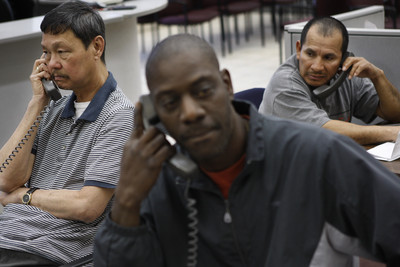Shrinking jobless fund might force Nevada to borrow from federal government
CARSON CITY -- Nevada's soaring unemployment rate will climb to a peak of 11.4 percent early next year and could force the state to ask for a federal loan to pay laid-off workers, according to an analysis released Wednesday.
With more and more laid-off workers seeking benefits, the unemployment trust fund is being depleted, and the state might have to borrow as much as $750 million from the federal government to continue paying benefits, state legislators were told.
Unemployment in Nevada hit 9.1 percent in December, the highest rate since 1983.
"The situation is not expected to improve anytime soon," said Cindy Jones, the administrator of the Employment Security Division.
She and Department of Employment, Training and Rehabilitation Director Larry Mosley told members of a pre-session legislative budget subcommittee that 128,100 Nevadans are out of work, referring to December figures.
After peaking at a 11.4 percent rate early next year, unemployment will drop slowly, but don't expect a recurrence of the booms of 2004-06, said Bill Anderson, chief economist for the department.
"Our rate of economic growth will be modest," he said in a telephone interview.
Mae Worthey, a spokeswoman for the employment department, said the state is not concerned that the federal government won't have money available to provide benefits for unemployed workers if Nevada needs a loan.
"People will get paid," she said.
The state of California began Monday to tap into a federal loan to cover its unemployment benefits. Unless changes are made to its system of taxing employers, the California unemployment trust fund is expected to be operating $4.9 billion in the red by the end of 2010, according to the San Jose Mercury News.
Ohio was given a $500 million federal loan on Jan. 12 so that it can continue to pay laid-off workers, although its trust fund has been exhausted.
The economic stimulus package passed Wednesday by the U.S. House of Representatives includes $27 billion to continue paying laid-off workers for 33 more weeks of benefits beyond the 26 weeks available through most state programs. It also would increase jobless benefits by $25 a week and provide job training.
Unlike other states with long-term problems, Nevada's trust fund drop just became evident.
Only seven weeks ago Jones decided to keep the unemployment insurance tax rate paid by businesses at 1.33 percent of each employee's wages.
She said she made the decision because of her concern that an increase would harm businesses during a recession. She sets the rate at the beginning of each year.
State economic analysts at that time estimated unemployment would top out at 8.8 percent at the end of 2009.
They also calculated the trust fund would not drop below $450 million by the end of 2009.
But now 78,000 Nevada residents are receiving unemployment benefits with checks averaging $300 a week and the trust fund could go into the red. The money comes from the tax paid by employers.
Even with the higher trust fund payout, Jones said, Nevada's fund is considered the 19th strongest in the country.
"But this crisis is one of the worst ever," she said.
Jones said the state is advocating for Congress to approve additional funds to states to cover unforeseen unemployment costs.
To keep up with the demand for unemployment benefits, Mosley and Jones seek legislative approval to hire more than 140 additional workers over the next two years.
Nevada has the fifth highest unemployment rate in the nation, with Michigan at the top with a 10.6 percent rate. As recently as June 2005, the unemployment rate in Nevada was 4 percent.
Mosley said the 1 percentage point increase in statewide unemployment in Nevada between November and December was the highest recorded by his agency. Several other states, however, also had that large of a gain over the month, he added.
Anderson said his prediction that unemployment will reach 11.4 percent did not take into consideration any employment gains that might result from the economic stimulus plan now in Congress.
"There are a lot of wild cards out there," he said.
State Archivist Guy Rocha has called the recession in Nevada the worst since the collapse of mining in the state in the 1880s and 1890s. Nevada lost population at the time, and there were moves in Congress to decertify Nevada as a state. Only 42,335 people lived in Nevada in 1900.
Nevada got through the Great Depression in the 1930s better than other states because it legalized gambling, built a quickie divorce industry, mainly in Reno, and benefited from federal works projects such as the construction of Hoover Dam, Rocha said.
Contact Capital Bureau Chief Ed Vogel at evogel@reviewjournal.com or 775-687-3901.

















